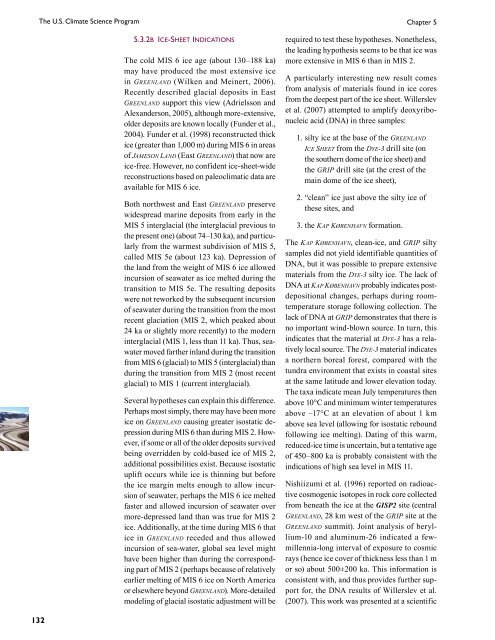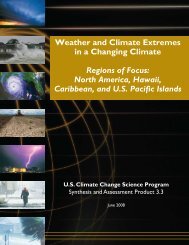Past Climate Variability and Change in the Arctic and at High Latitudes
Past Climate Variability and Change in the Arctic and at High Latitudes
Past Climate Variability and Change in the Arctic and at High Latitudes
Create successful ePaper yourself
Turn your PDF publications into a flip-book with our unique Google optimized e-Paper software.
132<br />
The U.S. <strong>Clim<strong>at</strong>e</strong> Science Program Chapter 5<br />
5.3.2b icE-shEEt <strong>in</strong>dic<strong>at</strong>ions<br />
The cold MIS 6 ice age (about 130–188 ka)<br />
may have produced <strong>the</strong> most extensive ice<br />
<strong>in</strong> GreenlAnd (Wilken <strong>and</strong> Me<strong>in</strong>ert, 2006).<br />
Recently described glacial deposits <strong>in</strong> East<br />
GreenlAnd support this view (Adrielsson <strong>and</strong><br />
Alex<strong>and</strong>erson, 2005), although more-extensive,<br />
older deposits are known locally (Funder et al.,<br />
2004). Funder et al. (1998) reconstructed thick<br />
ice (gre<strong>at</strong>er than 1,000 m) dur<strong>in</strong>g MIS 6 <strong>in</strong> areas<br />
of jAMeSon lAnd (East GreenlAnd) th<strong>at</strong> now are<br />
ice-free. However, no confident ice-sheet-wide<br />
reconstructions based on paleoclim<strong>at</strong>ic d<strong>at</strong>a are<br />
available for MIS 6 ice.<br />
Both northwest <strong>and</strong> East GreenlAnd preserve<br />
widespread mar<strong>in</strong>e deposits from early <strong>in</strong> <strong>the</strong><br />
MIS 5 <strong>in</strong>terglacial (<strong>the</strong> <strong>in</strong>terglacial previous to<br />
<strong>the</strong> present one) (about 74–130 ka), <strong>and</strong> particularly<br />
from <strong>the</strong> warmest subdivision of MIS 5,<br />
called MIS 5e (about 123 ka). Depression of<br />
<strong>the</strong> l<strong>and</strong> from <strong>the</strong> weight of MIS 6 ice allowed<br />
<strong>in</strong>cursion of seaw<strong>at</strong>er as ice melted dur<strong>in</strong>g <strong>the</strong><br />
transition to MIS 5e. The result<strong>in</strong>g deposits<br />
were not reworked by <strong>the</strong> subsequent <strong>in</strong>cursion<br />
of seaw<strong>at</strong>er dur<strong>in</strong>g <strong>the</strong> transition from <strong>the</strong> most<br />
recent glaci<strong>at</strong>ion (MIS 2, which peaked about<br />
24 ka or slightly more recently) to <strong>the</strong> modern<br />
<strong>in</strong>terglacial (MIS 1, less than 11 ka). Thus, seaw<strong>at</strong>er<br />
moved far<strong>the</strong>r <strong>in</strong>l<strong>and</strong> dur<strong>in</strong>g <strong>the</strong> transition<br />
from MIS 6 (glacial) to MIS 5 (<strong>in</strong>terglacial) than<br />
dur<strong>in</strong>g <strong>the</strong> transition from MIS 2 (most recent<br />
glacial) to MIS 1 (current <strong>in</strong>terglacial).<br />
Several hypo<strong>the</strong>ses can expla<strong>in</strong> this difference.<br />
Perhaps most simply, <strong>the</strong>re may have been more<br />
ice on GreenlAnd caus<strong>in</strong>g gre<strong>at</strong>er isost<strong>at</strong>ic depression<br />
dur<strong>in</strong>g MIS 6 than dur<strong>in</strong>g MIS 2. However,<br />
if some or all of <strong>the</strong> older deposits survived<br />
be<strong>in</strong>g overridden by cold-based ice of MIS 2,<br />
additional possibilities exist. Because isost<strong>at</strong>ic<br />
uplift occurs while ice is th<strong>in</strong>n<strong>in</strong>g but before<br />
<strong>the</strong> ice marg<strong>in</strong> melts enough to allow <strong>in</strong>cursion<br />
of seaw<strong>at</strong>er, perhaps <strong>the</strong> MIS 6 ice melted<br />
faster <strong>and</strong> allowed <strong>in</strong>cursion of seaw<strong>at</strong>er over<br />
more-depressed l<strong>and</strong> than was true for MIS 2<br />
ice. Additionally, <strong>at</strong> <strong>the</strong> time dur<strong>in</strong>g MIS 6 th<strong>at</strong><br />
ice <strong>in</strong> GreenlAnd receded <strong>and</strong> thus allowed<br />
<strong>in</strong>cursion of sea-w<strong>at</strong>er, global sea level might<br />
have been higher than dur<strong>in</strong>g <strong>the</strong> correspond<strong>in</strong>g<br />
part of MIS 2 (perhaps because of rel<strong>at</strong>ively<br />
earlier melt<strong>in</strong>g of MIS 6 ice on North America<br />
or elsewhere beyond GreenlAnd). More-detailed<br />
model<strong>in</strong>g of glacial isost<strong>at</strong>ic adjustment will be<br />
required to test <strong>the</strong>se hypo<strong>the</strong>ses. None<strong>the</strong>less,<br />
<strong>the</strong> lead<strong>in</strong>g hypo<strong>the</strong>sis seems to be th<strong>at</strong> ice was<br />
more extensive <strong>in</strong> MIS 6 than <strong>in</strong> MIS 2.<br />
A particularly <strong>in</strong>terest<strong>in</strong>g new result comes<br />
from analysis of m<strong>at</strong>erials found <strong>in</strong> ice cores<br />
from <strong>the</strong> deepest part of <strong>the</strong> ice sheet. Willerslev<br />
et al. (2007) <strong>at</strong>tempted to amplify deoxyribonucleic<br />
acid (DNA) <strong>in</strong> three samples:<br />
1. silty ice <strong>at</strong> <strong>the</strong> base of <strong>the</strong> GreenlAnd<br />
ice Sheet from <strong>the</strong> dYe-3 drill site (on<br />
<strong>the</strong> sou<strong>the</strong>rn dome of <strong>the</strong> ice sheet) <strong>and</strong><br />
<strong>the</strong> Grip drill site (<strong>at</strong> <strong>the</strong> crest of <strong>the</strong><br />
ma<strong>in</strong> dome of <strong>the</strong> ice sheet),<br />
2. “clean” ice just above <strong>the</strong> silty ice of<br />
<strong>the</strong>se sites, <strong>and</strong><br />
3. <strong>the</strong> kAp københAvn form<strong>at</strong>ion.<br />
The kAp københAvn, clean-ice, <strong>and</strong> Grip silty<br />
samples did not yield identifiable quantities of<br />
DNA, but it was possible to prepare extensive<br />
m<strong>at</strong>erials from <strong>the</strong> dYe-3 silty ice. The lack of<br />
DNA <strong>at</strong> kAp københAvn probably <strong>in</strong>dic<strong>at</strong>es postdepositional<br />
changes, perhaps dur<strong>in</strong>g roomtemper<strong>at</strong>ure<br />
storage follow<strong>in</strong>g collection. The<br />
lack of DNA <strong>at</strong> Grip demonstr<strong>at</strong>es th<strong>at</strong> <strong>the</strong>re is<br />
no important w<strong>in</strong>d-blown source. In turn, this<br />
<strong>in</strong>dic<strong>at</strong>es th<strong>at</strong> <strong>the</strong> m<strong>at</strong>erial <strong>at</strong> dYe-3 has a rel<strong>at</strong>ively<br />
local source. The dYe-3 m<strong>at</strong>erial <strong>in</strong>dic<strong>at</strong>es<br />
a nor<strong>the</strong>rn boreal forest, compared with <strong>the</strong><br />
tundra environment th<strong>at</strong> exists <strong>in</strong> coastal sites<br />
<strong>at</strong> <strong>the</strong> same l<strong>at</strong>itude <strong>and</strong> lower elev<strong>at</strong>ion today.<br />
The taxa <strong>in</strong>dic<strong>at</strong>e mean July temper<strong>at</strong>ures <strong>the</strong>n<br />
above 10°C <strong>and</strong> m<strong>in</strong>imum w<strong>in</strong>ter temper<strong>at</strong>ures<br />
above –17°C <strong>at</strong> an elev<strong>at</strong>ion of about 1 km<br />
above sea level (allow<strong>in</strong>g for isost<strong>at</strong>ic rebound<br />
follow<strong>in</strong>g ice melt<strong>in</strong>g). D<strong>at</strong><strong>in</strong>g of this warm,<br />
reduced-ice time is uncerta<strong>in</strong>, but a tent<strong>at</strong>ive age<br />
of 450–800 ka is probably consistent with <strong>the</strong><br />
<strong>in</strong>dic<strong>at</strong>ions of high sea level <strong>in</strong> MIS 11.<br />
Nishiizumi et al. (1996) reported on radioactive<br />
cosmogenic isotopes <strong>in</strong> rock core collected<br />
from bene<strong>at</strong>h <strong>the</strong> ice <strong>at</strong> <strong>the</strong> GiSp2 site (central<br />
GreenlAnd, 28 km west of <strong>the</strong> Grip site <strong>at</strong> <strong>the</strong><br />
GreenlAnd summit). Jo<strong>in</strong>t analysis of beryllium-10<br />
<strong>and</strong> alum<strong>in</strong>um-26 <strong>in</strong>dic<strong>at</strong>ed a fewmillennia-long<br />
<strong>in</strong>terval of exposure to cosmic<br />
rays (hence ice cover of thickness less than 1 m<br />
or so) about 500±200 ka. This <strong>in</strong>form<strong>at</strong>ion is<br />
consistent with, <strong>and</strong> thus provides fur<strong>the</strong>r support<br />
for, <strong>the</strong> DNA results of Willerslev et al.<br />
(2007). This work was presented <strong>at</strong> a scientific




